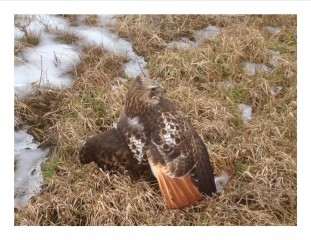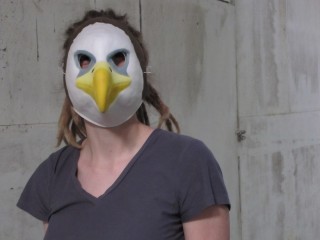
This red-tailed hawk was found along a trail with an obvious wing injury. The humerus, or upper wing bone, was fractured mid-shaft, which made her a good candidate for complete recovery.
Wildlife Rehabilitation is a fairly new field. It is very different working with domestic animals. At every stage of rehabilitation of a wild animal, we need to consider what we are doing to keep the animal wild. During the diagnosis, the first aid, and the initial and intensive care of a wild hawk or owl, it can be difficult to hide human faces, but it is important in keeping the bird from associating food with people. We need to keep the wild animal away from people, loud noises, pets, and anything associated with domestication.

Hiding the human face during rehabilitation is important, even though the birds may not recognize the mask as its own species. This mask was successfully used for raising a nestling bald eagle.
Our goal in rehabilitation is always to be able to release the hawk, owl, eagle, or falcon back into its natural environment in excellent condition, both mentally and physically. It must retain that acute alertness, that sensitivity to its surroundings, and that wildness that we appreciate, but is so elusive to describe.
Each bird must retain the natural condition that allows it to sense danger before it strikes, to locate and capture prey with skillful accuracy, and to fit into its habitat as it did before its term in human care.
This is really no easy task. But if we destroy that wild nature, or accustom these birds to humans who can so often be the enemy, we have done nothing to help the bird. If we release a young bird that has not first been given the chance to develop hunting skills, the young bird will not survive as a wild bird. Helping an individual, one bird at a time, is a large part of what rehabilitation is all about, but it must be done with the final goal in mind: a healthy, physically and mentally fit wild bird.
It is critical, also, to seek the best veterinary care, to work with the finder, the transportation, the volunteer, and all others who are recruited to assist in saving one bird. Each step of the way, judgments are made to create the best possible outcome so that this one bird is successful again as a wild bird.
And, as each bird travels the course of its rehabilitation, all those involved, from finder on, should have a chance to connect with that one bird that has been saved to fly free once more. For most, it is one of the most memorable experiences of a lifetime.